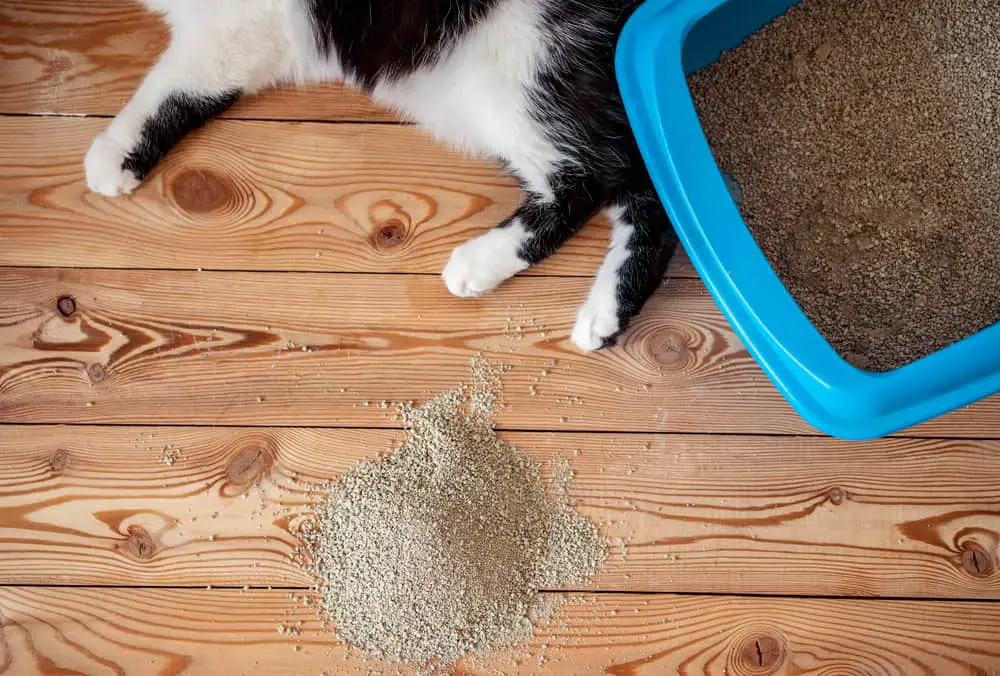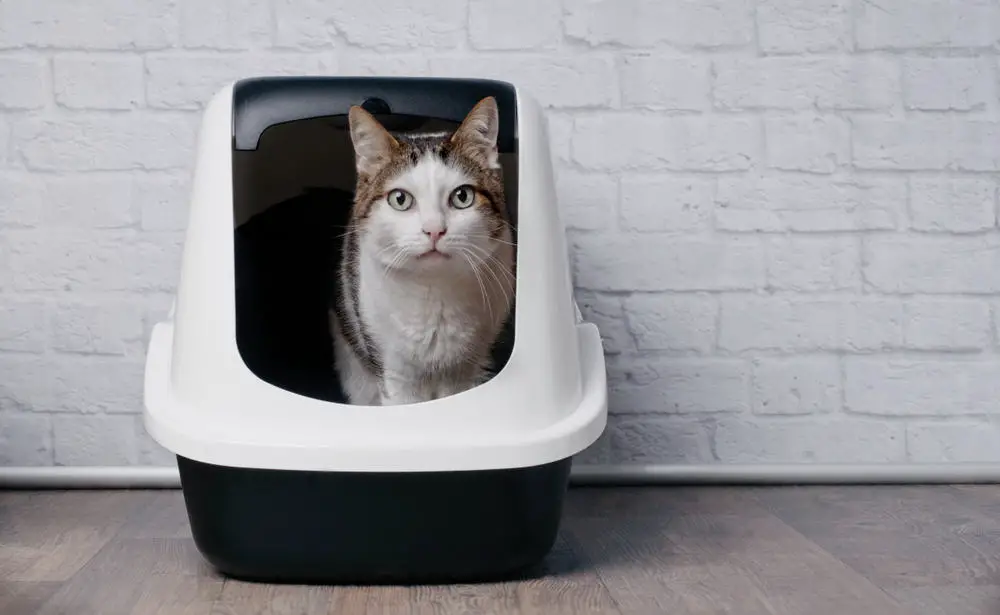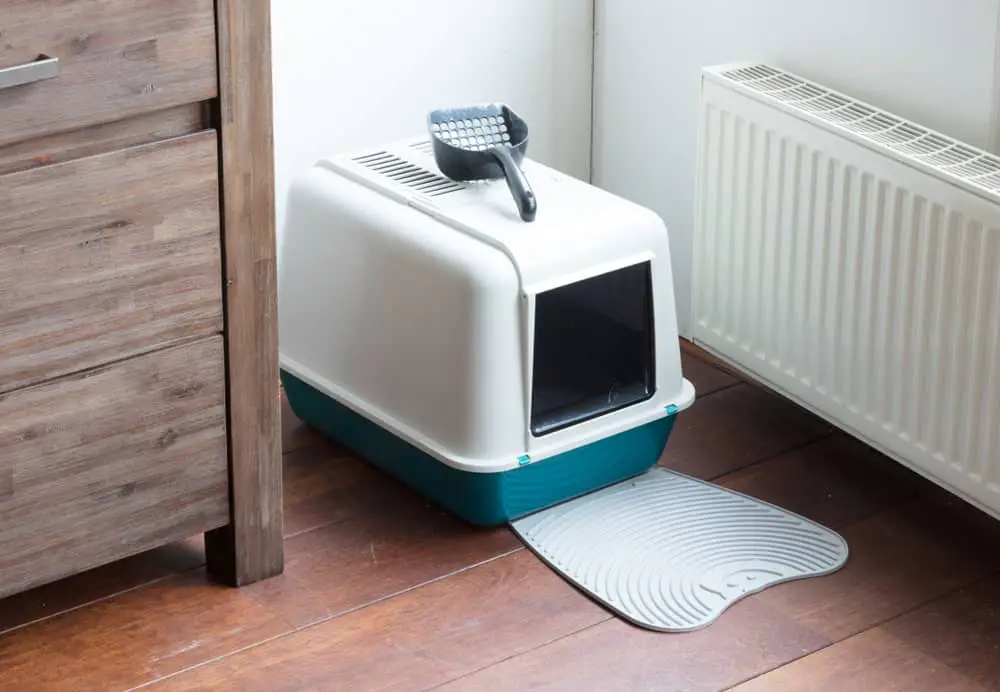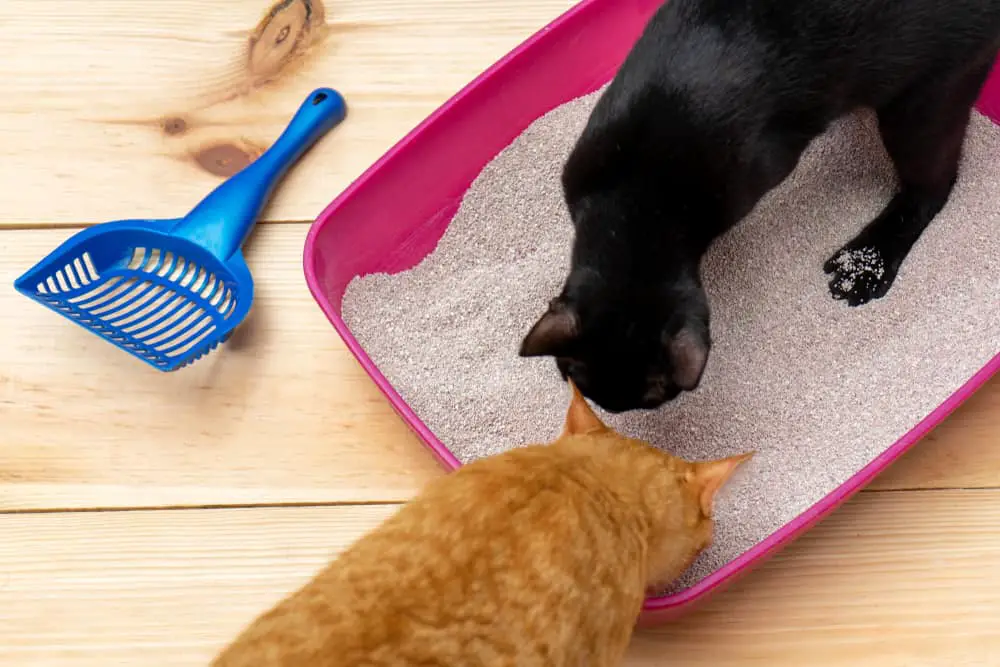This article is not a guide to hide the litter box nor is it a guide to make natural things look pretty but it is designed to help people to prevent and minimize the main problems when we think about the litter box within an apartment or studio apartment.
These problems are:
- Inappropriate elimination (going outside the litter box)
- Litter box tracking
- Litter box smells
The litter box can be a big source of pain to a lot of people, especially when it’s not doing what it’s meant to do or your cats are not using it.
For me, finding a perfect litter box set up was crucial in terms of my apartment’s cleanliness and productivity. Cleanliness is obvious but what about productivity?
Well if your cat has litter box problems or litter is flying everywhere – you’d be surprised how much stress it causes and how much time you might spend either cleaning up the messes or thinking about what’s wrong with your cats or the litter box setup.
What I’ve discovered, is that usually, the solutions to all of these litter box problems and setups are simpler than what we might think if we take into account the cat’s experience.
For those coming here with problems about your cats not going to the litter box properly and eliminating outside the litter box, I have a simple and easy-to-understand step-by-step guide at the bottom of the article.
Litter Box Requirements and Rules for Litter Box in Apartment
How a cat wants to use a litter box is going to be a bit different than how we want to see the litter box. Especially in a smaller space like an apartment. Generally, we butlers want to avoid seeing the thing (litter box) altogether. We want to hide it and get rid of any trace of it.
While this might be fine for a lot of people – but when things get more complicated: more cats, more people, or maybe a frequently changing environment. Where a cat chooses to do their business – whether it is in the litter box or out of it – should be a sign for us to take notice.
A cat actually has preferences for where they eliminate:
- It should be in a socially important area of the room
- Have adequate sight of what’s around them as they do their business
- Large enough to easily accommodate them
- Easy to access
- Acts as one of their main scent markers in the room
- As clean as possible
Don’t forget we butlers have preferences and requirements for the litter box set up too!
Our requirements for the litter box:
- Minimal litter tracking
- Minimal smell
- Minimal floor space is taken
- That cats actually use the litter box
So the perfect apartment litter box solution is to have the cat’s experience of going to the litter box to be completely instinctually satisfying – where the litter box becomes their scent signpost in a socially important area that’s easy to access and survey. While at the same time, also fulfilling the needs of their owners, for it to be clean (minimal litter tracking), neat, and as odorless as possible.
What Type of Litter To Use in an Apartment?
There are two concerns about the type of litter used: tracking and smell.
The smell is a pretty straightforward way to rank litter types. If you’re very sensitive about smells – sand (clay, bentonite) litter is usually the best at trapping smells. Tofu litter is probably the worst. Pine litter is somewhere in between.
Pine litter, baking soda, and used coffee grounds help a lot with the smell. So I would rank it almost to the level of the sand litter!
The second concern is litter tracking. This is the most important factor in tracking: the actual litter used. There’s always going to be some litter flying out the litter box but the question is: is there going to be litter carried to different parts of the apartment or home?

The key is to realize that the larger the litter types – the less it tracks and gets picked up around the home. And vice versa, the finer and smaller the litter granules – the more it’s going to stick to your cat’s paws and track. That means the sand litter that everyone has is, unfortunately, the worst type of litter to use if you’re sensitive to litter tracking.
The litter type that I always recommend for small spaces is going to be pine litter pellets. It’s simple to manage and clean, cheap, and best of all – it tracks very little. Complete guide on pine litter here.
It’s also very efficient and you never have to dump out the whole box because of the smell.
However, if pine litter pellets are not an option for you – then experiment with larger litter types until you and your cats can find a good compromise between what you want and what your cat wants.
Which Type of Litter Box for an Apartment?
There’s a lot of different types of litter boxes and designs that include a lot of features including litter tracking. However, the litter box design that you should be looking for is the hooded litter box.

There’s a hooded/hinged litter box for any type of litter and it provides so much flexibility for any type of situation you as a cat butler might be in.
I have the exact litter box that I am using on the recommended products page.
Here are some examples:
- Some cats dislike having enclosed boxes for their litter box and things a little bit more open to survey their environment while they do their business – lift the hood up
- Cats that have especially smelly…you know…keep the hood down
- Multi-cat home with cats that prefer open and closed boxes. Solution: one litter box with the hood up and one with the hood down
- Super young cats that need easy excess to the litter box – easy: keep the hood up.
- Guests coming over and you don’t want to display your cat’s poop – put the hood down
As you can see, whatever the situation might be or changes that might happen – you’re prepared to adapt to it quickly without having to make drastic changes to your litter box setup.
Control Odor/Smell From Litter Box
Out of all the smells associated with owning a cat. The litter box is probably the biggest offender. Cats can be adorable, but it’s always surprising how smelly their…presents can be!
This is also assuming you scoop your litter box daily or once every two days at least. Because of course, if you don’t scoop – the litter box is going to smell.
These are the most effective ways to reduce smells from the litter box:
- Used or fresh coffee grounds or baking soda to add to the litter itself. It takes away a lot of the ammonia punch and reduces the other odors as well. It keeps the litter smelling better for longer too.
- As mentioned above, use a hooded litterbox. It can reduce the spread of odors and keep the smells in.
- More ventilation. The one thing an apartment might lack is adequate airflow. Try to open doors or windows. Leave a space for the bad air to go out of the room. If you do not have adequate airflow, investing in a good air purifier that includes a carbon filter will help.
Recommended Cat Litter Odor Control Products
Add these products to your home to help with smells and odor control. Put some baking soda right after you scoop the litter box and it’ll keep it smelling fresh for longer.
For the air purifier, remember to always get one with a carbon filter to take out smells from the home/apartment.
 Arm & Hammer Baking Soda Double Duty Cat Litter Deodorizer
Arm & Hammer Baking Soda Double Duty Cat Litter Deodorizer
When you need that extra odor prevention, sprinkle a little into the sifting tray. Very useful when you need to get rid of odors quickly (like when guests come over).
 Germ Guardian HEPA + Charcoal/Carbon Filter
Germ Guardian HEPA + Charcoal/Carbon Filter
This air purifier is great for not only particles in the air but there is a carbon filter for smells and a UV light to help kill airborne germs and viruses. It also an antimicrobial agent that inhibits the growth of mold, mildew, and other odor-causing bacteria on the filter's surface.
To tackle other odors in the home/apartment, read my article: Control Cat Odors in An Apartment!
Where to Put the Litter Box in an Apartment?
I’ll keep this section short as I wrote a very in-depth article about the best place to put your litter box in a studio apartment.

Here are some key takeaways from the article above:
- Ease of access is important – the more hidden the litter box is, the more of a chance that something that might happen to push the cat away from using the litter box (whether it’s something surprising, frightening, or accidental locking off of the litter box area).
This is why I don’t recommend hiding the box in a cupboard or some other dark place in your home, it’s too out of the way for your cats. - The litter box is a major territorial signpost. We know cats are very territorial and how do they mark what is theirs? Scent. There are lots of things that hold your cat’s scent. The scratching post, couch maybe, toys, but out of all of those things, the strongest scent marker is their litter boxes.
Think about how much more confident your cat would be if you put the litter box right in the middle of the room where everything is happening. They’d be beaming with confidence.
Obviously, this isn’t the ideal location for the owners of the cats but we should consider our cat’s location preferences as well and end up with some sort of a compromise.
Where is a high traffic area where their scent can be used as a territorial marker to let other cats or animals know that this area belongs to them?
The other question to ask is: where is an area that there might not be a scent marker for your cats? - The ability to see what’s coming around them while they go to the litter box. The worst thing that might happen for a cat is to be ambushed or scared off from using the litter box. It creates such anxiety that they will avoid it altogether and go somewhere else.
Always put the box in a location where they can see what’s coming from all sides. If they can’t see from a certain side? Place the litter box near the wall to block it off so they know that there’s nothing coming from that direction.
While this may be a lot to think about with the placement – it can make the difference between a cat going to their litter box or…somewhere else.
Should I Hide the Litter Box Inside an Apartment?
I’ve already answered this question in part in the other section but it’s not recommended to hide the litter box. It introduces more problems than it might solve (not wanting to see the litter box itself).
However, if you’re already doing it and it’s working for you – I’m always on the camp, if it works then keep doing it. However, if in the future (knock on wood) that your cat’s behavior toward their litter box changes – you’ll know what to do to guide them again in the right direction…or box.
How Many Litter Boxes Should I Use?
Clicking on the link will lead you to my in-depth article about this question. However – the easy and simple answer is probably just one litter box. Apartments are generally small enough that you don’t need many litter boxes.
Larger places may need two litter boxes. In my studio apartment with 4 cats, I use two litter boxes. When I had 3 cats – I used one litter box.

Cats can easily share a litter box as long as they tolerate each other and have been introduced correctly. For those looking to introduce cats, I created a guide in which requires no isolation or slow introduction processes.
What to Do When Your Cats Eliminate Outside the Litter Box?
Your cats are going outside the litter box and you’re losing your mind and sleep? Let’s go through the solutions checklist from the easiest and least effort required to the hardest, most efforts required.
Before going through this solution checklist remember to first make sure that medical issues are eliminated and there is nothing physically (like an unfriendly cat or dog) or mentally that might be affecting your cat’s behaviors.
This list also assumes you are scooping the litter box every day and it’s relatively clean. Remember, just because they like their own scent – doesn’t mean they like a dirty litter box. Keep it clean and if you’re using sand litter – clean out and dump your litter box biweekly.
Again, this list is focused on the minimal amount of effort to make your cat use their litter box properly and consistently. Leaving the more drastic changes as a last resort (changing litter boxes/changing litter).
Cat Inappropriate Elimination Solutions Checklist For Apartments
- Make the litter box more open (if you have a hooded litter box, just lift the hood) . If it’s another type of litter box with a lid – remove the lid completely and see how they react to it for a day or two. If the cat still goes outside the litter box, go to the next step.
- Making notes from the “Where to Put the Litter Box” section above. Move the litter box to a new location that fulfills the requirements and key points of the above section. Quickly, the points are:
– Easy to access
– In a socially important area or an area with high traffic of people or other animals
– Able to easily see what’s going on around them and is difficult to be ambushed/scared
Remember to also leave the litter box open (keep the hood up) for this step. Ease of access will attract your cats to the new litter box location.
If the cat still goes outside the litter box, go to the next step. - Change the litter box. However, before you actually go ahead and buy a new litter box, try a very large box (larger than the litter box you’re currently using).
It could be that the litter box that you are currently using is too small – so a larger box is a good test to see if it works and the cat is happy with using it.
If they are started to use the litter box (congratulations!) – then you can go ahead and purchase a new litter box that is similar to the box’s size or larger than the current litter box.
—
If the larger box doesn’t work – try a box that is incredibly easy to access. No high walls and very easy to step in and out of. While this might introduce a lot of litter mess – this is used as a test to see if litter box accessibility is the issue.
If they started to use it again, great – purchase the new litter box that’s similar to the box you have now with low walls and easy to access.
If the cat still goes outside the litter box, go to the next step. - Change the litter type. If you’re using pellets, then maybe switch to a finer and smaller litter type. If you’re using fine litter such as sand, switch to pine pellets.
Observe and make note of the litter type that your cat prefers using and continue to use that type of litter. You can slowly transition again to another type of litter later or you can make a mix of different types of litters to fit your needs (smell, tracking, etc.).
Go to the next step if your cat still has problems going in the litter box. - Hire a cat behaviorist/Start recording and monitoring your apartment for unusual things – while this might be the most expensive and drastic step, sometimes desperate times call for desperate measures.
There are times when it’s none of the above and it’s caused by something you have no idea that is happening. For example, it’s not uncommon for another foreign cat or animal to sneak into the apartment without the owner knowing and thus causing territorial issues for the resident cat.
If you still have questions and related experiences – I’d love to hear them down in the comments. I’ll get to them as soon as possible!

Where did you get the Litter Box that looks like a tower where the white cat is seating?
Hi! I’m not sure which one you mean? You can check the recommended page to see if it’s there!